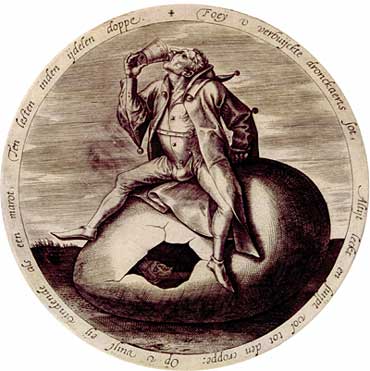
‘Mad man on a broken egg’, engraving after Pieter Breughel, musée de Gravelines collection.
|
|
Musée du Dessin et de l’Estampe Originale de Gravelines
Château de Gravelines
59820 Gravelines
Contact :
Tél : 03 28 24 99 70 - Fax : 03 28 24 99 71
site : www.ville-gravelines.fr
e-mail : musee.de.gravelines@wanadoo.fr
Hours of admission :
Open everyday except Tuesday, from 2pm to 5pm, and 3pm to 6pm Saturday and Sunday.
Curators :
Claude Gaignebet
Dominique Tonneau-Ryckelynck
Entrance fee :
Adults : 2 €
Fre: under 21 and students.
Press :
Emmanuel Gilliot
Tél : 03 28 24 99 70 - Fax : 03 28 24 99 71
e-mail : service.com.musee.de.gravelines@wanadoo.fr

|
It’s the carnival season and the Gravelines Museum of Prints and Drawings is fittingly dedicating its first exhibition of the year to the festivities and mascarades of the Carnival over the centuries.
A topsy-turvy world
Over one hundred prints from the 16th to the 20th century trace the various stages of the carnival story from its beginning when the archetypal fools – Polichinelle, Harlequin and the Idiot Mother, break out of an egg filled with the winds of madness, to the end of Mardi Gras at midnight, when the disguised revellers unveil themselves and the lights go out.
First there is Breughel, whose ‘Battle of the Carnival and Lent’ faithfully reproduces the Flemish celebrations, customs and religious traditions from Christmas to Easter. Then there is Bertelli, Bûner, Callot, Choweicki, Franco, Goya, Hogarth, Chartinet, Pinelli, Verbiest or Zelenko, who illustrate this topsy-turvy world.
Feather-clad men sacrifice animals who are treated as kings, masked lepers run out from their hemp cabins, the world is turned on its head and the liberating laughter of the carnival rules supreme
The Spirit of the flat country.
Since the 13th century, in every town in Picardy and Flanders, carnival brotherhoods from the ‘Simpletons of Douais’ to the ‘Fools of Amiens’ and the ‘Grotesques of Combrai’ have organised carnival activities.
Carnaval, Carrus Navalis, or Naval tank, the etymology is debatable but the festival fits perfectly within the life-cycle of a country where boats are rolled out of the water during winter, the canal barges look like they are floating on wheat instead of water, and they burn the carnival guy with husks of hemp once the hemp has been combed out.
In a place like this, such an upside-down-world seems almost natural. Little surprise therefore, thatt hese ‘Triumphs’ should be created here.
Publication
.Catalogue to appear in February 2004.
|








